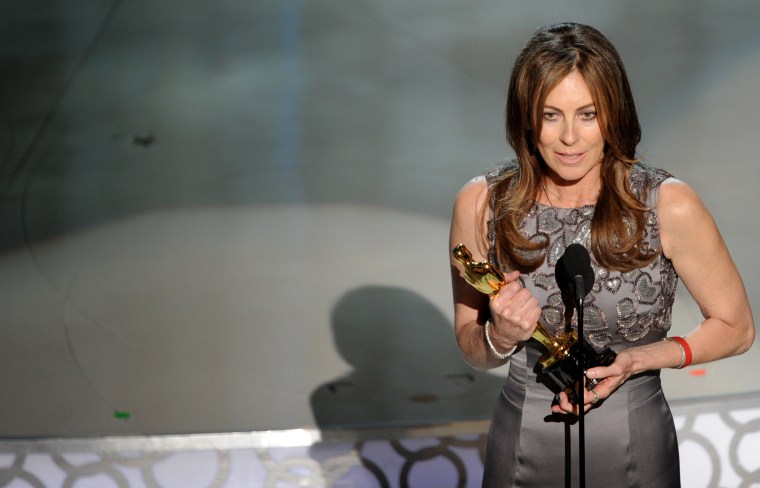The morning the 2020 Academy Award nominations were announced, co-presenter Issa Rae followed up the announcement of the five names in the best director category with an ad-libbed line that summed up the feelings of so many tired film fans: “Congratulations to those men.”
In the 92-year history of the Oscars, only five women have been nominated for best director, and only one woman — Kathryn Bigelow — has won, for 2009’s “The Hurt Locker.” This year’s nominees —Bong Joon Ho, Sam Mendes, Todd Phillips, Martin Scorsese and Quentin Tarantino — again all men and again mostly white. Rae’s impromptu Oscars jab was tweeted, repeated and emblazoned on T-shirts. But the same thing happened in 2018, when Natalie Portman announced, “Here are the all-male nominees,” when she presented the same category at the Golden Globes.
When women are shut out, fans, critics and artists complain. Op-eds are written, and outrage is registered. Yet, nothing changes. The still-majority male Academy of Arts and Motion Pictures cannot be prevailed upon to fairly acknowledge women directors.
Still, these directors are churning out thought-provoking, engaging, transformative work. 2019 brought audiences Lulu Wang’s “The Farewell,” Lorene Scafaria’s “Hustlers,” Chinonye Chukwu’s “Clemency,” Céline Sciamma’s “Portrait of a Lady on Fire” and Marielle Heller’s “A Beautiful Day in the Neighborhood,” just to name a few impressive women-directed films. Those movies collectively received one nod: Tom Hanks is up for supporting actor for his performance as Fred Rogers. With six nominations, Greta Gerwig’s “Little Women” adaptation received the most academy attention among films not helmed by men. Still, she herself was shut out for best director category.
As this inequality persists, members of the film community are campaigning for structural solutions.
In a guest column last month for “The Hollywood Reporter,” Martha M. Lauzen, executive director of the Center for the Study of Women in Television and Film at San Diego State University, argued for an expansion of the best director category. In 2010, the academy raised the cap on best picture nominees to 10; in Lauzen’s scenario, the number of best director nominees would be equal to best picture contenders each year. (Others have advocated for this shift simply because it’s bizarrely incongruous that a film be up for best picture but not best director.)
“Expanding the number of directors nominated in the category would increase the chances that women and members of other underrepresented groups would be included, without diminishing the significance of the award or patronizing the nominees,” Lauzen writes. Of course, there’s no guarantee that more slots would lead to more diversity. Indeed, it’s possible that we would have nine or 10 male nominees instead of the more traditional five.
There’s no guarantee that more slots would lead to more diversity. Indeed, it’s possible that we would have nine or 10 male nominees instead of the more traditional five.
Filmmaker Alma Har’el, who could have been nominated this year for her festival hit “Honey Boy,” spoke out in Entertainment Weekly for what would certainly be a more controversial alteration of the rules. She advocates for two director awards, in male and female categories.
"The status quo will always protect itself by getting women and underrepresented filmmakers to play a game they can’t win. By making us believe that anything other than breaking into the white boys’ club is failure,” Har’el explains. To the filmmaker, providing female directors a category of their own isn’t exclusion, but instead, a way to “build a new world that celebrates us.” She does, however, acknowledge that this configuration isn’t useful to nonbinary directors, who’ve been left out of the conversation entirely.
During an interview with Variety at this year’s Sundance Film Festival, “Promising Young Woman” actor Carey Mulligan proposed that academy members be required to “prove” that they’ve seen the films they’re voting on. “There are a lot of movies, a lot of performances per year for us to watch,” an anonymous voter told the New York Post this year, before admitting that they sometimes rely on the “brand” of a nominee instead of watching a film.
“Little Women” producer Amy Pascal told Vanity Fair that twice as many women than men RSVP'd to early screenings of the film, suggesting that male voters were skipping it. She blamed unconscious bias, not active sabotage, but the effect is still insidious. Voters think that "these kinds of stories are important to me, and these kinds of stories are less important to me,” Pascal said.
It’s Mulligan’s proposal that could have the most comprehensive effect, not just on the Oscars but on the industry itself. The academy is working toward diversifying its membership, but it’s a lengthy process, and voters are still predominantly male and white. When voters only pay attention to the stories that pertain to them, the result is more often than not a monochromatic, staid list of nominees that doesn’t come close to representing the best of the art form or include the biggest risk takers. Given the Oscars’ power, the ripple effect goes far beyond the ceremony itself.
But how could such a system be instituted? Voters for the Tony Awards cannot vote in categories that include a production they haven’t seen. But it’s much easier to monitor attendance at live events than to determine whether someone has watched a screener in their own home.
What’s not in doubt is that the academy cannot continue hoping its problem will fix itself. The nominations have become a source of shame instead of celebration. For the Oscars to continue to have any credibility, it must not only accommodate but deliberately arrange for inclusion across categories.
If voters need to have their hands held in order to break out of this embarrassing rut, so be it.


